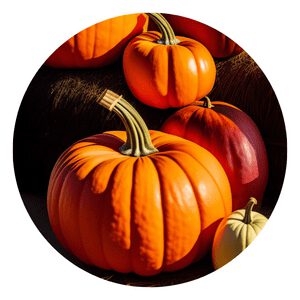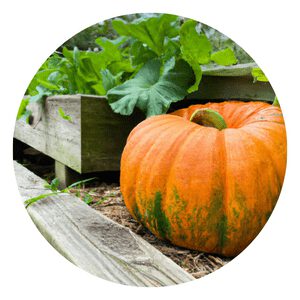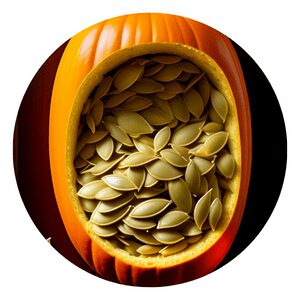Why Are My Pumpkin Leaves Turning Brown and Dying?
As autumn sets in and the air turns crisp, many gardeners eagerly await the arrival of their beloved pumpkins.
With visions of jack-o’-lanterns and homemade pies dancing in their heads, they carefully tend to their pumpkin plants, nurturing them with love and attention.
But what happens when those vibrant green leaves suddenly start to turn brown and wither away?
Panic sets in as questions arise: What is causing this sudden decline?
Can it be saved? In this article, we will explore the reasons behind why pumpkin leaves may be turning brown and dying, providing valuable insights and practical solutions for preserving your precious pumpkins.

Pumpkin Leaves Menu
Water Stress
Water stress is a common cause for brown and dying pumpkin leaves. This occurs when the plant does not receive enough or receives too much water.
Inconsistent watering can be detrimental to pumpkin plants, as it interrupts their growth patterns and leads to stress.
To prevent water stress, it is crucial to maintain consistent moisture in the soil. However, finding the perfect balance can be tricky.
Overwatering can lead to root rot and fungal diseases, which in turn result in brown and wilting leaves. On the other hand, underwatering causes dehydration and nutrient deficiencies, manifesting as browning and drying out of leaves.
Therefore, it is essential for gardeners to monitor their pumpkin plants closely by regularly checking the soil moisture level.
A good practice is to provide sufficient water when the top inch of soil feels dry but not completely dried out.
By maintaining consistent moisture levels without overwatering or underwatering, gardeners can minimize water stress on their pumpkin plants and promote healthy leaf growth.
Fungal Diseases
Fungal diseases can wreak havoc on your pumpkin plants, causing their once-vibrant leaves to turn brown and wither away.
Two common culprits are powdery mildew and downy mildew, both of which thrive in humid conditions.
Powdery mildew appears as a white powder-like substance on the surface of the leaves, while downy mildew forms a fuzzy grayish underside. These diseases not only detract from the beauty of your pumpkins but also weaken their overall health.
To combat these fungal invaders, fungicides can be an effective tool. However, it’s essential to choose a fungicide specifically formulated for powdery or downy mildew and follow all instructions carefully.
Alternatively, you can adopt cultural practices that reduce humidity levels around your plants. Providing adequate spacing between each pumpkin plant will improve air circulation and prevent moisture buildup on the foliage.
Remember that prevention is always better than cure when it comes to fungal diseases.
Applying organic sprays like neem oil or potassium bicarbonate early in the growing season can often keep powdery and downy mildews at bay. Keep an eye out for any signs of infection and take action promptly if needed.
With proper care and attention, your pumpkin patch will stay healthy and vibrant throughout the growing season.
Bacterial Infections
Bacterial infections can wreak havoc on pumpkin plants, causing their vibrant green leaves to wilt and turn brown.
One particularly troublesome bacterial disease that affects pumpkins is bacterial wilt. This destructive infection is caused by the bacterium Erwinia tracheiphila and spreads through cucumber beetles that feed on infected plants.
Once the bacteria enters a pumpkin plant, it quickly multiplies, clogging the plant’s water-conducting tissues and preventing essential nutrients from reaching its leaves.
To combat bacterial infections like wilt, it’s crucial to act promptly and remove infected plants as soon as symptoms are spotted.
Not only will this limit further spread of the disease within your pumpkin patch, but it may also protect neighboring plants from becoming infected. It’s important to note that bacteria can survive in garden debris or soil for extended periods; therefore, proper disposal of affected plants is essential to prevent future outbreaks.
Implementing good sanitation practices such as cleaning tools thoroughly between uses can also help reduce the risk of spreading bacterial infections among healthy pumpkin plants.
In my garden's autumn realm, a sight so dreary, My pumpkin leaves now tainted, their hue turned weary. Once vibrant green, they danced beneath the warm sun, Now wilted and lifeless, their grieving begun. Why do you falter, oh leaves of cherished grace? Why are you fading in this sacred space? Seeking answers amidst the decay and strife, I pledge to tend your wounds, restore life to this strife.
Chappy The Gardener
Pest Infestations
Pumpkin plants are not immune to the wrath of insect pests.
In fact, squash bugs and cucumber beetles are common culprits that can wreak havoc on pumpkin leaves, causing them to turn brown and wither away.
The damage inflicted by these tiny intruders not only affects the appearance of your pumpkin patch but can also hinder the growth and development of the fruit itself.
Luckily, there are organic pest control methods that can effectively manage infestations without relying on harmful chemicals.
One approach is to employ companion planting by placing marigolds around your pumpkin plants.
Marigolds act as natural repellents for many insect pests, including squash bugs and cucumber beetles.
Additionally, introducing beneficial insects such as ladybugs or lacewings into your garden can help keep these pests in check by feeding on their eggs and larvae.
Another effective strategy is practicing crop rotation.
By moving your pumpkin plants to a different location each year, you disrupt the life cycle of pest populations that may have developed in the soil during previous seasons. This decrease in available host plants can significantly reduce infestations, leading to healthier and more vibrant pumpkin leaves.
Managing pest infestations organically not only protects your pumpkins from damage but also promotes a healthier ecosystem within your garden.
By harnessing the power of nature’s own defenses, you can enjoy bountiful harvests while minimizing harm to beneficial insects and other organisms that contribute to a thriving environmen
Nutrient Deficiencies
Nutrient deficiencies are a common cause of poor leaf health in pumpkin plants.
Among the essential nutrients, nitrogen plays a crucial role in the growth and development of leaves.
When there is inadequate nitrogen in the soil, the plant’s ability to produce chlorophyll is affected, leading to brown and dying leaves.
To ensure your pumpkin plants receive adequate nutrition, it is important to provide them with balanced organic fertilizers that contain nitrogen.
Organic fertilizers are an ideal choice for promoting nutrient balance in the soil.
Unlike synthetic fertilizers that can cause excessive leaching and harm beneficial soil organisms, organic options release nutrients slowly over time. This steady release ensures a consistent supply of essential elements like nitrogen without overwhelming the plant or causing nutrient imbalances.
Additionally, organic fertilizers improve soil structure, enhance moisture retention capacity, and promote healthier microbial communities – all factors that contribute to better absorption and utilization of nutrients by pumpkin plants.
By focusing on providing balanced organic fertilizers for your pumpkin plants’ nutritional needs, you can minimize the risk of nutrient deficiencies and promote healthy leaf growth.
Remember that maintaining adequate levels of nitrogen alone may not be sufficient; other key nutrients such as phosphorus, potassium, calcium, magnesium must also be present in appropriate amounts for optimal plant development.
Regularly monitoring leaf health and adjusting fertilizer applications accordingly will help you safeguard against nutrient deficiencies and ensure vibrant foliage throughout the growing season.
Root Problems
One common root problem that can cause pumpkin leaves to turn brown and die is root rot.
Root rot occurs when the roots become waterlogged, which deprives them of oxygen and promotes the growth of harmful pathogens. This can happen if the soil does not provide adequate drainage or if there is overwatering.
To prevent root rot and other root issues, it’s crucial to ensure well-draining soil for your pumpkin plants. You can achieve this by adding organic matter like compost or peat moss to improve the soil structure.
Additionally, avoid compacting the soil around the roots by gently loosening it with a garden fork. This will allow water to drain freely and reduce the risk of root problems.
Proper care of the roots is also essential in preventing brown and dying pumpkin leaves.
Avoid overwatering by allowing the top inch of soil to dry out between waterings. Keep in mind that different environmental conditions may require adjusting your watering schedule accordingly.
Regularly inspect your plants for any signs of root issues, such as discolored or mushy roots, and promptly address any problems you find.
Taking proactive measures to ensure healthy roots not only helps prevent leaf browning but also contributes to overall plant health and productivity
Environmental Stress
One of the major factors causing pumpkin leaves to turn brown and wither is environmental stress, specifically extreme heat or drought conditions.
When exposed to high temperatures without sufficient access to water, pumpkin plants struggle to regulate their moisture levels, leading to dehydration and ultimately, leaf damage.
To combat this issue, it is important for gardeners and farmers alike to provide shade during hot periods. This can be achieved by using shade cloth or even simply planting taller crops nearby that can offer some degree of protection from the scorching sun.
In addition to shading techniques, maintaining consistent moisture levels is vital in preventing environmental stress on pumpkin plants.
Regular watering should be done early in the morning or late in the evening when evaporation rates are lower and soil has time to absorb the water properly. It’s also worth considering implementing a drip irrigation system, which allows for controlled water delivery directly at the plant’s base while minimizing excess evaporation.
With these strategies in place, you can help your pumpkins thrive even under stressful weather conditions.
Overcrowding
Overcrowding is a common mistake made by many gardeners when planting pumpkins. While it may be tempting to maximize space and squeeze in as many plants as possible, doing so can have detrimental effects on their health.
When pumpkins are planted too closely together, there is limited air circulation and sunlight available to each plant. This lack of space and light can lead to the overcrowded plants competing for these vital resources, causing them to grow weak and susceptible to diseases.
To combat overcrowding and improve leaf health, thinning out crowded plants is crucial. By removing excess seedlings or transplants, you provide ample room for the remaining pumpkins to receive the necessary airflow and sunlight they need for optimal growth.
Additionally, thinning out crowded plants allows extra nutrients from the soil to be distributed more effectively among the remaining ones, promoting stronger root development and overall plant vigor.
So next time you find yourself tempted to pack your pumpkin patch with closely spaced plants, remember that overcrowding can compromise their well-being. Take a step back and assess if your pumpkin patch has enough breathing room.
Give your precious pumpkins the space they deserve so that their leaves can thrive, ensuring a bountiful harvest full of vibrant green foliage instead of browned, dying leaves
Pruning Issues
Pruning is an essential maintenance practice for any gardener, but it can also be a double-edged sword if not done correctly.
While pruning is meant to promote healthy growth and remove diseased or damaged parts of the plant, it’s crucial to avoid overdoing it or doing it incorrectly.
When excessive pruning occurs, healthy leaves may be mistakenly removed along with targeted branches. This can spell trouble for your pumpkin plants as these leaves play a vital role in the process of photosynthesis.
Photosynthesis is the life force that sustains every plant, enabling them to convert sunlight into energy. Healthy leaves are responsible for absorbing light and turning it into fuel for growth.
When overly pruned, a pumpkins’ ability to absorb sufficient sunlight becomes compromised, resulting in stunted growth and weakened overall health.
It’s important to prune judiciously by only removing what is necessary and appropriate for optimal growth.
Moreover, one must always consider proper sterilization techniques when pruning plants.
The use of unsterilized tools can transmit diseases from one plant to another through open wounds created during the pruning process. This transmission of pathogens can wreak havoc on your pumpkin patch, not only causing brown and dying leaves but potentially spreading illness throughout your entire garden bed.
Viral Infections
Viral infections can wreak havoc on pumpkin plants, causing their leaves to turn brown and eventually die. These infections are caused by viruses that affect the plant’s cells, leading to discoloration and curling of leaves.
Unfortunately, there is no cure for viral infections in pumpkin plants, which makes prevention and control extremely important.
One of the key methods to prevent viral infections in pumpkins is practicing good sanitation. This means removing any infected plant debris promptly and disposing of it properly.
Additionally, regular hand washing or sanitizing tools used in the garden can help prevent the spread of viruses between plants.
Another crucial aspect of preventing viral infections is controlling insect vectors that may carry and transmit these viruses from one plant to another.
Aphids, in particular, are known to be common carriers of many pumpkin-infecting viruses. Using physical barriers like row covers or insect netting can help keep aphids away from your pumpkin plants.
By understanding how viral infections can affect your pumpkin plants and taking proactive steps towards prevention, you can minimize leaf discoloration and curling, helping your pumpkins thrive throughout the growing season
In conclusion, there are several possible reasons why pumpkin leaves may be turning brown and dying.
It could be due to a lack of water or excessive heat, which can cause stress on the plant. Fungal diseases such as powdery mildew or bacterial infections may also be to blame.
Nutrient deficiencies, particularly in nitrogen or potassium, can result in unhealthy leaves.
Lastly, pest infestations like aphids or spider mites can weaken the plant and cause leaf damage.
To prevent further browning and dying of pumpkin leaves, it is important to maintain proper watering and provide shade during hot weather.
Regularly inspecting plants for signs of disease or pests and providing appropriate treatments can help keep the plants healthy.
Click To Grow
Helps Us Grow – Share If You Like
















